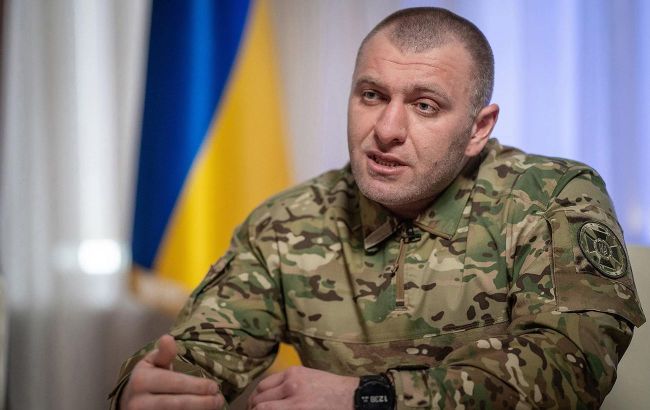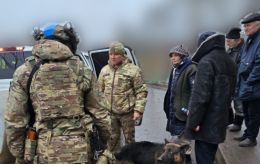Ukraine's Operation Spiderweb: Security Service chief reveals details
 Photo: Head of the SBU Vasyl Malyuk (facebook.com/SecurSerUkraine)
Photo: Head of the SBU Vasyl Malyuk (facebook.com/SecurSerUkraine)
During the Security Service of Ukraine's (SBU) special operation, Spiderweb, certain difficulties arose. In particular, the truck drivers were Russian citizens, and it was because of them that the operation had to be postponed for a month, states the head of the Security Service of Ukraine, Vasyl Malyuk, in an interview aired during the national telethon.
According to him, Spiderweb is a unique, multi-stage special operation that includes a number of critically important components.
"First and foremost, it is logistics — that is, delivering the equipment itself into the enemy’s rear, which in our case means 150 combat FPV drones. It is the delivery of small shelters, which then bring the equipment to the airfields. It is, accordingly, intelligence work, communications, and more," Malyuk said.
He explained that the Security Service of Ukraine drew on its experience in combating transnational crime, studying in detail how international drug cartels covertly transport prohibited substances to various parts of the world, bypassing customs and border authorities.
And it was precisely in this area that the SBU achieved significant results long before the war, detaining criminals who transported record shipments of heroin, cocaine, and other narcotics.
"Using this invaluable experience, my team and I engaged in delivering the necessary equipment, essentially, into the enemy’s rear. In addition, we delivered the corresponding shelters there. Each of these shelters is a fully autonomous so-called hunting cabin. Inside, there were EcoFlow batteries, solar panels, and other groups of goods," Malyuk said.
According to him, this made it possible to continuously power the drones that were already supposed to be in their combat formations.
"In case our operation took place during the colder season, and in those time zones the temperature can drop below minus 40 degrees, the drone had to be fully charged," explained the head of the SBU.
At the same time, as Malyuk noted, it was difficult to bring these shelters into Russian territory because all these groups of goods cannot simply enter Russia due to sanctions.
"I won’t go into all the details, but believe me, we went through seven circles of hell to make this happen," he added.
According to the head of the SBU, there were no smugglers at the border, but there were Russian customs authorities, who are essentially very corrupt. And at some point, this actually played a certain positive role in delivering the shelters.
"Another critically important element is the drones themselves. At first glance, the drones look like ordinary FPV drones, but these are unique drones. They were specially designed for this operation and have several types of communication systems, though I will not publicly discuss the details or tactical and technical specifications," Malyuk added.
The combat part of each drone consisted of two warheads weighing 800 grams each, made from a special mixture developed specifically for this operation.
"Essentially, this mixture and the drone itself are shaped-charge explosive devices. They are designed to burn through the aircraft’s fuselage and cause an explosive blast inside, followed by ignition, which we have already seen later as the burning of aviation fuel stored in the aircraft’s fuel tanks," explained the head of the SBU.
Malyuk separately noted the work of their compatriots.
"If we look at Spiderweb as a whole, it is a comprehensive effort combining intelligence and technical work. In other words, it is a symbiosis of intelligence and technical components. In this case, we are witnesses to such a unique operation," he said.
At the same time, there were many difficulties related to briefing Ukrainian agents, since they were located far away and were trained via video communication.
"Because what they were doing was very narrowly specialized technical work. They themselves formed the combat formations of the drones in the shelters, organized logistics, and so on. Together with our covert helpers behind enemy lines, we created a logistics campaign," the head of the SBU said.
According to him, five suitable vehicles were purchased, an office and warehouse premises were rented — all located within one block of the FSB headquarters in the Chelyabinsk region.
"So we felt calm there, because everything was under FSB control. For some time, we worked on perfecting our cover story so that it would, let’s say, take hold. The drivers performed various functions, transporting different groups of goods until the time came when they needed to deliver our shelters," Malyuk added.
When everything was ready and the drones were in their combat formations, the shelters were dispatched. However, during the process, a number of technical problems arose. Some of the communication devices on the drones lost contact within a minute of being activated because this group of goods could not operate in Russia.
After everything was ready and the SBU sources had positioned the drones, the drivers left Chelyabinsk heading to the designated airfields. Each was given a specific location where they were to arrive and deliver their shelter. Supposedly, a buyer was to come there, pay for the shelter, and pick it up.
As Malyuk explained, the drivers were Russian citizens. They were used in the dark (without their knowledge - ed.) and had no intent in their actions.
"It’s strange that today, Russia is holding them in FSB detention centers and torturing them. In fact, they did nothing illegal, and there was no intent in their actions. They came there, and by the way, we paid them very generously and thanked them for their work. They did a good job," he added.
Meanwhile, on the day the shelters departed Chelyabinsk for the airfields, the SBU sources reportedly left Russia under the pretense of going on vacation. There, they received new documents with different identities and then entered Ukrainian territory.
"The operation took place on June 1, a Sunday, and by Thursday, our sources were already here, on Ukrainian territory. They came to me and were transferred to the combat operations center. I personally had the honor of embracing them and thanking them. And right there, I witnessed how they continued to monitor their drivers in a covert phone conversation — and those drivers were behind the wheel heading to the airfields," Malyuk added.
The head of the SBU also noted that the special operation Spiderweb had to be postponed for a month because the Russian truck drivers "got drunk" during the May holidays.
"We had planned Spiderweb even before May 9, but the drivers went on a binge during Easter. Our sources couldn’t reach them. One driver was missing, then another. Then came the May Day holidays, then May 9. We actually lost a month, I’ll be frank with you, all because of this root cause," he explained.
Special operation Spiderweb
On June 1, the Security Service of Ukraine (SBU) struck Russian airfields using drones. The special operation was named Spiderweb. It turned out that the Security Service had been working on this operation for a year and a half.
The head of the SBU, Vasyl Malyuk, reported that the attack damaged 41 Russian aircraft. Most of them were strategic bombers.
The drones struck four military bases: Belaya, Dyagilevo, Olenya, and Ivanovo.
The SBU also calculated how much the Russian Federation lost in a single day due to the Ukrainian special operation.

